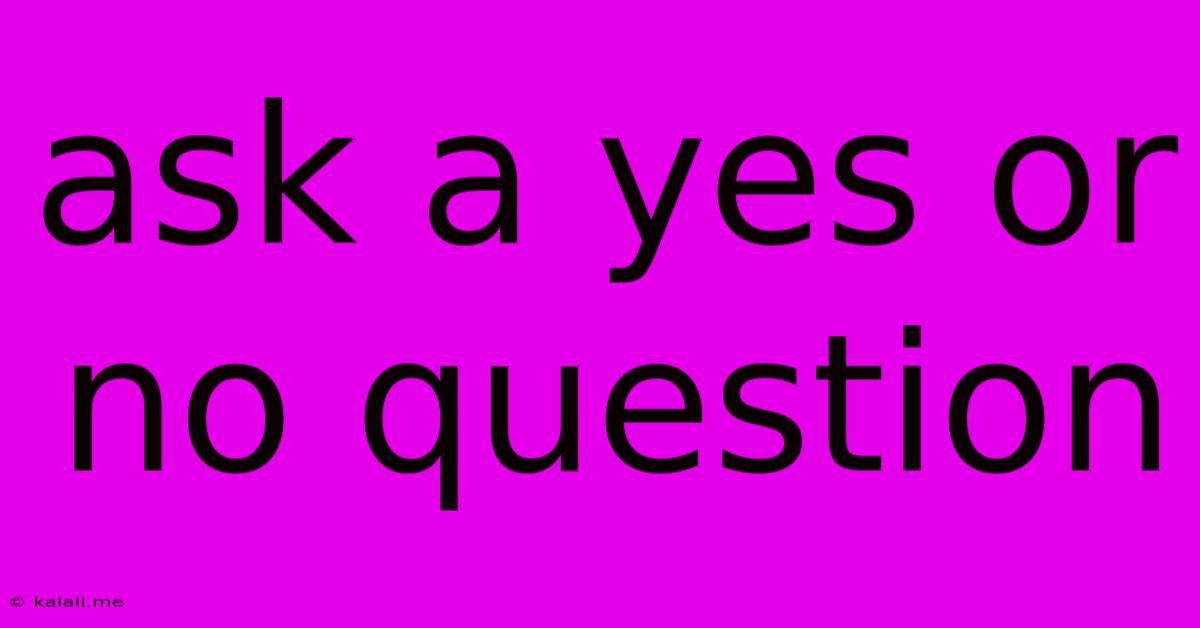Ask A Yes Or No Question
Kalali
Jun 04, 2025 · 3 min read

Table of Contents
Mastering the Art of the Yes/No Question: A Guide to Crafting Effective Queries
Asking a yes or no question seems simple, right? But the effectiveness of this seemingly straightforward query depends heavily on context, clarity, and intent. This article will explore the nuances of crafting impactful yes/no questions, covering everything from their practical applications to potential pitfalls. We'll delve into how to use them effectively in various scenarios, from casual conversations to formal interviews, and even how to optimize their use in surveys and questionnaires.
Why Use Yes/No Questions?
Yes/no questions serve several crucial purposes. They're efficient for:
- Gathering quick information: When you need a simple confirmation or denial, a yes/no question is the most direct route.
- Filtering options: In surveys or interviews, they can help narrow down possibilities and guide the conversation.
- Confirming understanding: They're excellent for ensuring both parties are on the same page.
- Guiding decision-making: By presenting a binary choice, they can facilitate quick decisions.
- Starting conversations: A simple yes/no question can be an effective conversation starter, particularly in casual settings.
Crafting Effective Yes/No Questions:
While seemingly straightforward, crafting an effective yes/no question requires careful consideration:
- Clarity and Precision: Avoid ambiguity. Use clear and concise language, ensuring the question is easily understood. For example, instead of "Are you busy?", try "Are you available for a call this afternoon?".
- Specificity: The question should target a specific piece of information. Broad questions can lead to vague answers. Instead of "Do you like it?", try "Do you find the color appealing?".
- Avoiding Leading Questions: A leading question implies a desired answer. This biases the response. For instance, "Don't you agree this is a great product?" is leading; "Do you agree this is a great product?" is more neutral.
- Considering the Context: The appropriateness of a yes/no question depends on the situation. A formal setting might require more formal language than a casual conversation.
- Single Focus: Each yes/no question should focus on a single idea or piece of information. Avoid combining multiple questions into one.
Potential Pitfalls of Yes/No Questions:
Over-reliance on yes/no questions can be limiting. They:
- Restrict Detailed Responses: They often prevent respondents from elaborating on their answers, potentially missing valuable insights.
- Can Be Misinterpreted: The simplicity can sometimes lead to misunderstandings or inaccurate responses.
- Limit Nuance: They don't account for complex situations or opinions that aren't easily categorized into a simple "yes" or "no."
When to Use Alternative Question Types:
While yes/no questions have their place, remember that open-ended questions ("Tell me about your experience…"), multiple-choice questions, and rating scales can provide richer, more nuanced data.
Conclusion:
Yes/no questions are valuable tools for quick information gathering and decision-making. However, understanding their strengths and limitations is crucial for effective communication and data collection. By following these guidelines, you can craft clear, concise, and impactful yes/no questions that serve your purpose efficiently. Remember to consider the context, avoid leading questions, and be mindful of the potential for limiting detailed responses. Balance their use with other question types to gain a more comprehensive understanding.
Latest Posts
Latest Posts
-
Quantum Theory Of Many Particle Systems Book Ch1 Discussion
Jun 06, 2025
-
How To Wire A Cigarette Plug
Jun 06, 2025
-
Are Medical Equipment Not Considered A Carry On
Jun 06, 2025
-
Google Apps Script Round To Nearest 15 Number
Jun 06, 2025
-
Why Did The Elder Wand Belong To Harry
Jun 06, 2025
Related Post
Thank you for visiting our website which covers about Ask A Yes Or No Question . We hope the information provided has been useful to you. Feel free to contact us if you have any questions or need further assistance. See you next time and don't miss to bookmark.